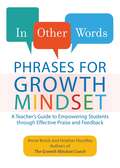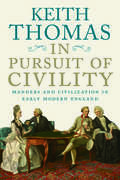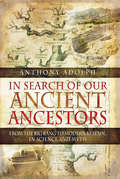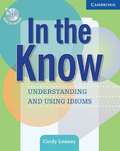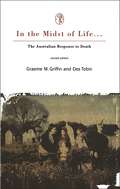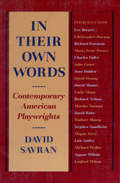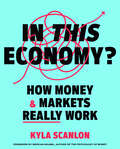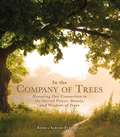- Table View
- List View
In Memoriam
by Amanda Bennett Terence B. FoleyThis practical, innovative guide takes friends and family through every step of planning a funeral or memorial service. It also offers detailed advice on how to make any service truly personal--from writing tributes and choosing appropriate music to selecting speakers, organizing the time and place, arranging flowers, and much more.
In Other Words: A Teacher's Guide to Empowering Students through Effective Praise and Feedback (Growth Mindset for Teachers)
by Annie Brock Heather HundleyLearn how to effectively bring growth mindset into your community and classroom by choosing impactful language.From the authors of the bestselling The Growth Mindset Coach, this handy companion is a must-have if you want to empower students through purposeful praise and feedback. Here are the key strategies, helpful tips and go-to phrases for helping students transition thoughts, words and actions into the growth-mindset zone.Designed for ease of use and packed with over a hundred specific examples, this book offers a “say this, not that” approach to communication that will help you model and cultivate growth mindset in the classroom. For example:Fixed Mindset:• You’re so smart.• You’re wrong.Growth Mindset:• l like how you used different strategies to figure out these problems.• That didn’t work out for you. How could you approach the problem differently?
In Other Worlds: Essays In Cultural Politics (Routledge Classics)
by Gayatri Chakravorty SpivakIn this classic work, Gayatri Chakravorty Spivak, one of the leading and most influential cultural theorists working today, analyzes the relationship between language, women and culture in both Western and non-Western contexts. Developing an original integration of powerful contemporary methodologies – deconstruction, Marxism and feminism – Spivak turns this new model on major debates in the study of literature and culture, thus ensuring that In Other Worlds has become a valuable tool for studying our own and other worlds of culture.
In Praise of England: Inspirational Quotes and Poems From William Shakespeare to William Blake
by Paul HarperEngland’s beautiful landscapes and rich histories have long moved great writers and poets to capture their glory. Ranging from timeless prose to lyrical poetry, from incisive wit to thoughtful social commentary, these stirring volumes collect the most Inspiring praise for our beloved countries.
In Praise of England: Inspirational Quotes and Poems From William Shakespeare to William Blake
by Paul HarperEngland’s beautiful landscapes and rich histories have long moved great writers and poets to capture their glory. Ranging from timeless prose to lyrical poetry, from incisive wit to thoughtful social commentary, these stirring volumes collect the most Inspiring praise for our beloved countries.
In Praise of Famous Horses: An A-Z of the Most Celebrated in History and Culture, Myth and Sport
by Sean MageeHorses is an A-Z companion to perhaps the most loved of all domesticated animals. The book's entries include a wealth of unexpected, fascinating and serendipitous information, from horse-slang phrases to horses in British pub signs, and from the horse in advertising to the horse as a food item. Themes such as the horse in warfare and the horse in folklore abound.These features add up to a richly satisfying accumulation of information about the horse's role in human culture and society over two millennia. Horses will not only be a helpful reference source and congenial bedside book for those who work with or enjoy horses, but also a satisfying and browsable companion for the inquisitive general reader.
In Praise of Ireland
by Paul HarperIreland's beautiful landscapes and rich histories have long moved great writers and poets to capture their glory. Ranging from timeless prose to lyrical poetry, from incisive wit to thoughtful social commentary, these stirring volumes collect the most inspiring praise for our beloved countries.
In Praise of Ireland
by Paul HarperIreland's beautiful landscapes and rich histories have long moved great writers and poets to capture their glory. Ranging from timeless prose to lyrical poetry, from incisive wit to thoughtful social commentary, these stirring volumes collect the most inspiring praise for our beloved countries.
In Praise of Scotland
by Paul HarperScotland's beautiful landscapes and rich histories have long moved great writers and poets to capture their glory. Ranging from timeless prose to lyrical poetry, from incisive wit to thoughtful social commentary, these stirring volumes collect the most inspiring praise for our beloved countries.
In Praise of Scotland
by Paul HarperScotland's beautiful landscapes and rich histories have long moved great writers and poets to capture their glory. Ranging from timeless prose to lyrical poetry, from incisive wit to thoughtful social commentary, these stirring volumes collect the most inspiring praise for our beloved countries.
In Pursuit of Civility: Manners And Civilization In Early Modern England (The Menahem Stern Jerusalem Lectures)
by Keith ThomasWhat did it mean to be ‘civilized’ in Early Modern England? Keith Thomas's seminal studies Religion and the Decline of Magic, Man and the Natural World, and The Ends of Life, explored the beliefs, values and social practices of the years between 1500 and 1800. In Pursuit of Civility continues this quest by examining what the English people thought it meant to be `civilized' and how that condition differed from being `barbarous' or `savage' . Thomas shows how the upper ranks of society sought to distinguish themselves from their social inferiors by developing distinctive forms of moving, speaking and comporting themselves - and how the common people in turn developed their own forms of civility. The belief of the English in their superior civility shaped their relations with the Welsh, the Scots and the Irish. By legitimizing international trade, colonialism, slavery, and racial discrimination, it was fundamental to their dealings with the native peoples of North America, India, and Australia. Yet not everyone shared this belief in the superiority of Western civilization. In Pursuit of Civility throws light on the early origins of anti-colonialism and cultural relativism, and goes on to examine some of the ways in which the new forms of civility were resisted. With all the author’s distinctive authority and brilliance - based as ever on wide reading, abounding in fresh insights, and illustrated by many striking quotations and anecdotes from contemporary sources - In Pursuit of Civility transforms our understanding of the past. In so doing, it raises important questions as to the role of manners in the modern world.
In Pursuit of Hitler: A Battlefield Guide to the Seventh (US) Army Drive (Battleground Europe)
by Andrew RawsonThis book is a chronology of the Rise and Fall of the Third Reich and the famous victory drive of the Seventh Army. It starts at the Worms Rhine bridgehead and moves quickly onto Aschaffenburg, before describing the Hammelburg Raid to release US POWs. The seizure of Nuremberg was hugely symbolic and this beautiful city was the scene both of the infamous Nazi Rallies and of course the War Crimes Tribunals. The road to Munich, always worth visiting (bierfest or no bierfest!) is via the Danube crossings and the book takes in the liberation of the appalling Dachau Concentration Camp and the battle at the SS Barracks. Munich was the center of Hitlers early life and represented his power base. He was imprisoned here and wrote Mein Kampf. The book climaxes with the approach to the Alps and the superb Eagles Nest, so popular with tourists.
In Search Of the Obvious: The Antidote for Today’s Marketing Mess
by Jack TroutMarketing guru Jack Trout clears up the confusion that surrounds the marketing profession.
In Search of Our Ancient Ancestors: From the Big Bang to Modern Britain, In Science and Myth
by Anthony AdolphA top genealogist &“shows how genetics helps and how it roots each of us in this magnificent story of Life on Earth in the most meaningful way imaginable.&”—Reunite Magazine &“What a fine long pedigree you have given the human race.&”—Charles Darwin to Charles Lyell, 1863 How distantly are we related to dinosaurs? How much of your DNA came from Neanderthals? How are the builders of Stonehenge connected to great-grandpa? According to science, life first appeared on Earth about 3,500 million years ago. Every living thing is descended from that first spark, including all of us. But if we trace a direct line down from those original life forms to ourselves, what do we find? What is the full story of our family tree over the past 3,500 million years, and how are we able to trace ourselves so far back? From single-celled organisms to sea-dwelling vertebrates; amphibians to reptiles; tiny mammals to primitive man; the first Homo sapiens to the cave painters of Ice Age Europe and the first farmers down to the Norman Conquest, this book charts not only the extraordinary story of our ancient ancestors but also our 40,000-year-long quest to discover our roots, from ancient origin myths of world-shaping mammoths and great floods down to the scientific discovery of our descent from the Genetic Adam and the Mitochondrial Eve. &“Having read it I&’m still slightly shell-shocked by the range of topics that he covers, from the origins of the universe and life on Earth to the present-day DNA analysis that aims to answer some of our questions about our past. And everything in between!&”—LostCousins
In Search of an Identity: The Politics of History Teaching in Hong Kong, 1960s-2000 (East Asia: History, Politics, Sociology and Culture)
by Edward VickersFirst Published in 2003. Routledge is an imprint of Taylor & Francis, an informa company.
In Search of the Blues
by Marybeth HamiltonIn this extraordinary reconstruction of the origins of the blues, historian Marybeth Hamilton demonstrates that the story as we know it is largely a myth. Following the trail of characters like Howard Odum, who combed Mississippi's back roads with a cylinder phonograph to record vagrants, John and Alan Lomax, who prowled Southern penitentiaries and unearthed the rough, melancholy vocals of Leadbelly, and James McKune, a recluse whose record collection came to define the primal sounds of the Delta blues, Hamilton reveals this musical form to be the culmination of a longstanding white fascination with the exotic mysteries of black music.By excavating the history of the Delta blues, Hamilton reveals the extent to which American culture has been shaped by white fantasies of racial difference.
In The Know: Understanding And Using Idioms
by Cindy LeaneyIn the Know teaches over 800 colorful idioms in English. The book groups the idioms into units depending on whether the idioms relate to such concepts as danger or honesty, or whether they contain colors or parts of the body, etc. Each unit has a clear four-page format that presents the idioms, explores their meaning, and practices their use.
In The Midst Of Life
by Des Tobin Graeme M GriffinThis is a thoroughly useful, authoritative and compassionate book about the last taboo subject-death. In exploring our responses to death, it reveals a great deal about Australian society. There is grim humour in the practical details of burial in the days of pick and shovel-and a priest if you were lucky. Stories of elaborate Victorian mourning etiquette, of poignant personal histories recorded on gravestones, of vehement debates about cremation, and much more, make good reading. The authors-a theologian and a funeral director-use this frank social history to look at questions we often avoid. What is grief? How can we help ourselves and others through it? What choices do we have for farewelling our loved ones? Are the rituals of churches, funeral parlours and cemeteries flexible enough to meet our endlessly varied needs? Both professional and general readers will find many answers and yet more questions in this informative and reassuring book.
In Their Own Words
by David SavranIncludes: Lee Breuer, Christopher Durang, Richard Foreman, Maria Irene Fornes, Charles Fuller, John Guare, Joan Holden, David Henry Hwang, David Mamet, Emily Mann, Richard Nelson, Marsha Norman, David Rabe, Wallace Shawn, Stephen Sondheim, Megan Terry, Luis Valdez, Michael Weller, August Wilson and Lanford Wilson.
In Their Shoes
by Deborah ReberFOLLOW IN THE FOOTSTEPS OF AMAZING WOMEN WHO HAVE THE JOBS OF YOUR DREAMS! Find out what you really want to know about your career choices: What will I do every day? Will I wear Prada or Old Navy? Play with kids on the playground, or with bigwigs in the boardroom? Power lunch at the Ivy, or bag lunch at my desk? What kind of education do I need? This book is packed full of answers. "Day in the life" profiles will inspire you, while a ton of sidebars, lists, and helpful tips will get you started right away on finding the career that's right for you. Discover words of wisdom from women in the workforce, including: Shonda Rhimes, creator and executive producer of Grey's Anatomy, who thinks her job is like running a small country -- PAGE 2 Susan Schulz, editor in chief of CosmoGIRL!, who compares her life to both a chess game and the prom -- PAGE 289 U.S. Senator Barbara Boxer, who says that if you're passionate about an issue, you can turn it into a career -- PAGE 283 Browse through the profiles to find the job that's right for you, or use the career chooser to narrow your search. Packed with informative and inspirational advice from women at every stage of their careers, In Their Shoes is a must-have reference for every aspiring working girl!
In This Economy?: How Money & Markets Really Work
by Kyla Scanlon&“Few people can communicate how the economy actually works better than Kyla Scanlon.&”—Morgan Housel, author of The Psychology of MoneyAn illustrated guide to the mad math and terrible terminology of economics, from one of the internet&’s favorite financial educatorsIs our national debt really a threat? What is a &“mild&” recession, exactly? If you&’re worried about your bank account balance, job security, or mortgage rate, what data should you be keeping tabs on? For anyone trying to make sense of disorienting headlines, there&’s no better interpreter than Kyla Scanlon. Through her trademark blend of witty illustrations, creative analogies, and insights from behavioral economics, literature, and philosophy, Scanlon breaks down everything you need to know about how money and markets really work. This indispensable handbook reveals the hidden forces driving key economic outcomes, the most common myths to steer clear of, and the dusty, outdated assumptions that constrain our political imagination, offering a bold new path to building a prosperous society that works for everyone.
In a Manner of Speaking: Phrases, Expressions, and Proverbs and How We Use and Misuse Them
by Colin McnairnWhat do "the whole kit and caboodle,” "the whole shebang,” "the whole megillah,” "the whole enchilada,” "the whole nine yards,” "the whole box and dice,” and "the full Monty” have in common? They’re all expressions that mean "the entire quantity,” and they’re all examples of the breadth and depth of the English-speaking world’s vocabulary. From the multitude of words and phrases in daily use, the author of this delightful exploration into what we say and why we say it zeroes in on those expressions and sayings and their variations that are funny, quirky, just plain folksy, or playfully dressed up in rhyme or alliteration. Some may have become clichés that, as it’s said with "tongue in cheek,” should be "avoided like the plague. ” Others have been distorted, deemed politically incorrect, or shrouded in mystery and must bear some explanation. Among the topics the author delves into are expressions that shouldn’t be taken literally ("dressed to kill” and "kick the bucket”), foreign expressions that crept into English ("carte blanche,” "carpe diem,” and "que sera, sera”), phrases borrowed from print ads and TV commercials ("where there’s life, there’s Bud” and "where the rubber meets the road”), animal images ("a barrel of monkeys” and "chasing your tail”), and food and drink ("cast your bread upon the water,” "chew the fat,” "bottom’s up!”, and "drink as a lord”). Here’s a book for everyone who delights in the mysteries of language and the perfect gift for all the "wordies” in your life.
In the Company of Crows and Ravens
by John M. Marzluff Tony Angell"Crows and people share similar traits and social strategies. To a surprising extent, to know the crow is to know ourselves."--from the Preface From the cave walls at Lascaux to the last painting by Van Gogh, from the works of Shakespeare to those of Mark Twain, there is clear evidence that crows and ravens influence human culture. Yet this influence is not unidirectional, say the authors of this fascinating book: people profoundly influence crow culture, ecology, and evolution as well. John Marzluff and Tony Angell examine the often surprising ways that crows and humans interact. The authors contend that those interactions reflect a process of "cultural co-evolution." They offer a challenging new view of the human-crow dynamic--a view that may change our thinking not only about crows but also about ourselves. Featuring more than 100 original drawings, the book takes a close look at the influences people have had on the lives of crows throughout history and at the significant ways crows have altered human lives. In the Company of Crows and Ravens illuminates the entwined histories of crows and people and concludes with an intriguing discussion of the crow-human relationship and how our attitudes toward crows may affect our cultural trajectory.
In the Company of Trees: Honoring Our Connection to the Sacred Power, Beauty, and Wisdom of Trees
by Andrea Sarubbi FereshtehFascinating facts, trivia, and stories celebrating nature and the magnificent life of trees and their invaluable place in our lives, including beautiful, full-color photographs throughout.When was the last time you spent time outside? The space between your front door and your car doesn’t count. Nature holds incredible power to soothe our spirits, calm our minds, and open us up to creativity, if we can unplug long enough to step away from our screens and embrace it. And while they say you can’t see the forest for the trees, they play perhaps the leading role in our enjoyment of the outdoors. In the Company of Trees helps you rediscover your own connection to the world outside, with over 195 quotes, facts, and stories honoring trees from across the world and in our own back yards alike. Inviting, full-color photos of sun-dappled forests and tree-filled hikes throughout will inspire you to do some forest-bathing of your own and embrace the healing power of nature.
In the Front Row: How Australian Fashion made the World Stage
by Simon P LockIn the Front Row charts the rise of Australian Fashion Week, from one man's ambition to take Australian fashion to the world, to the glittering international event it is today. Simon P. Lock's determination placed Sydney on the international fashion week circuit, up there with New York, London, Milan and Paris.Lock's story takes you backstage for the twenty years that Fashion Week has wowed the world. It tells the story of daring designers, supermodels and celebrities and details how Australia's biggest fashion stars—Akira Isogawa, Collette Dinnigan, Peter Morrissey, Wayne Cooper, sass & bide, Zimmermann, Dion Lee and Ellery—got their start. He reveals the parts Miranda Kerr, Elle Macpherson, Linda Evangelista, Dita Von Teese and Cate Blanchett played in this often drama-filled adventure.In the Front Row reveals the feuds, frustrations and triumphs of producing one of Australia's most fabulous international events.

